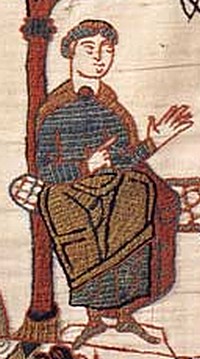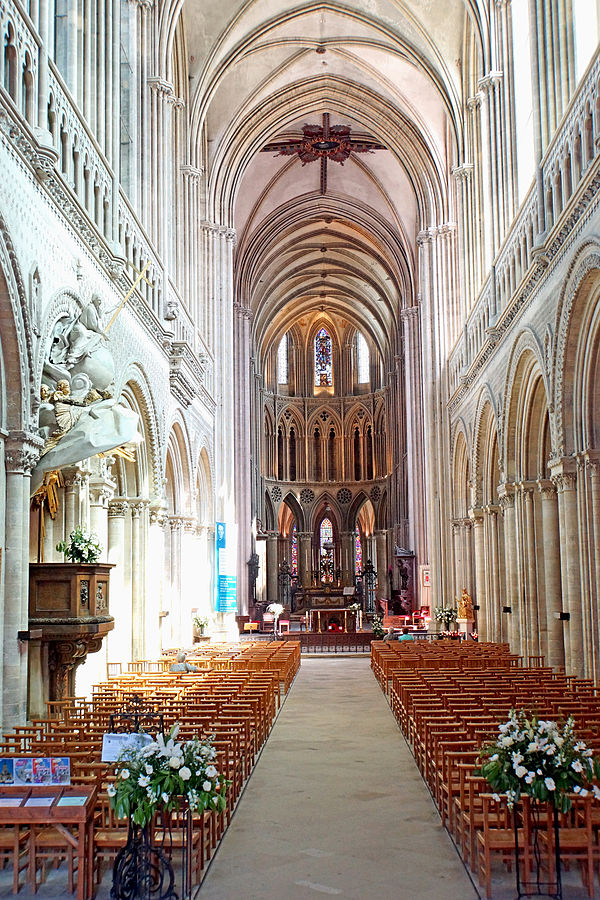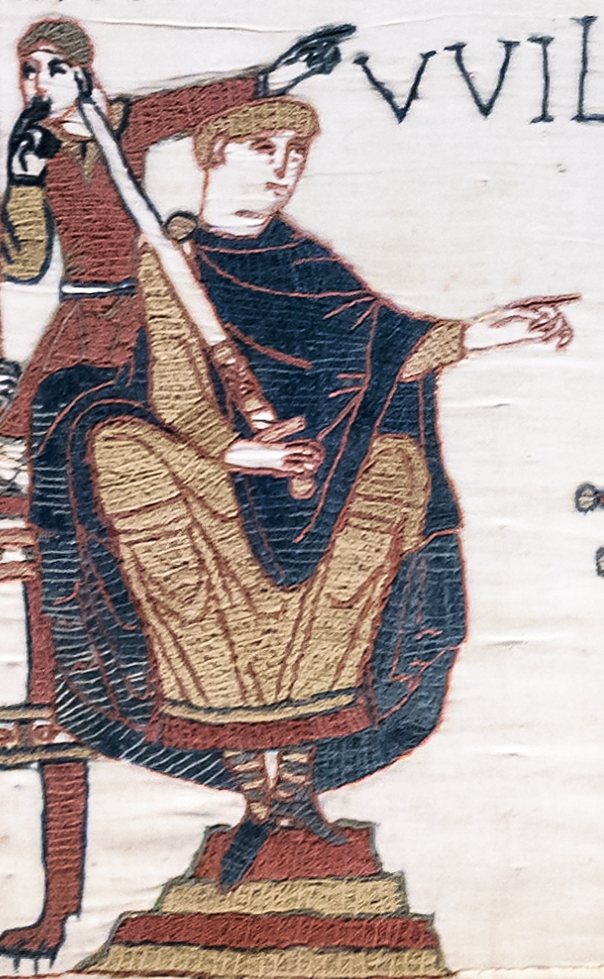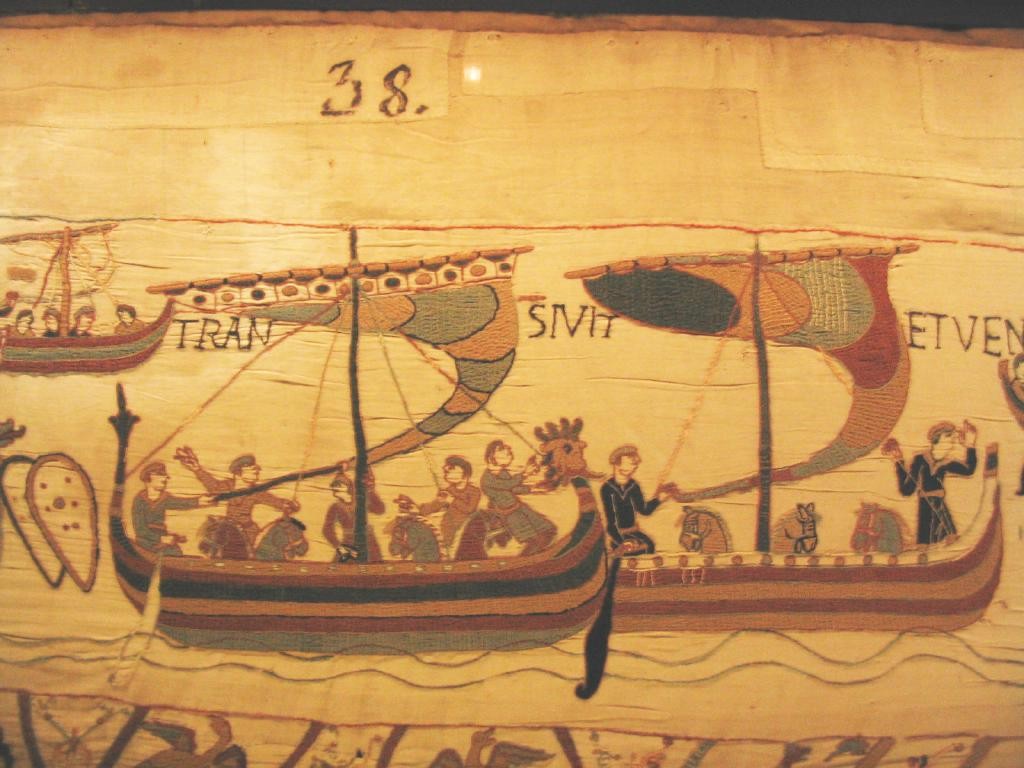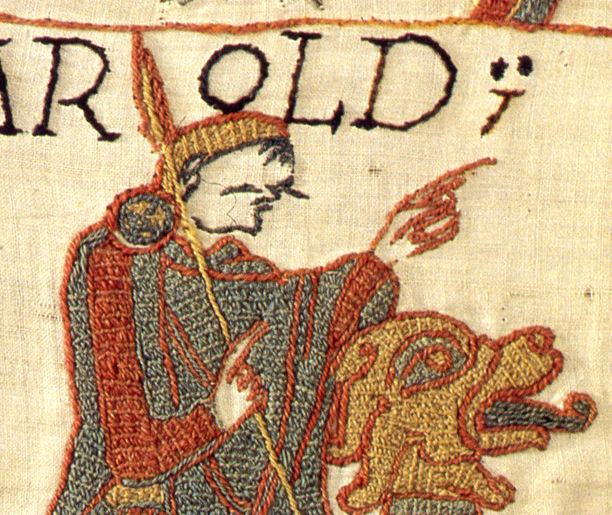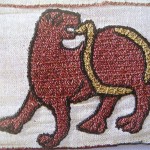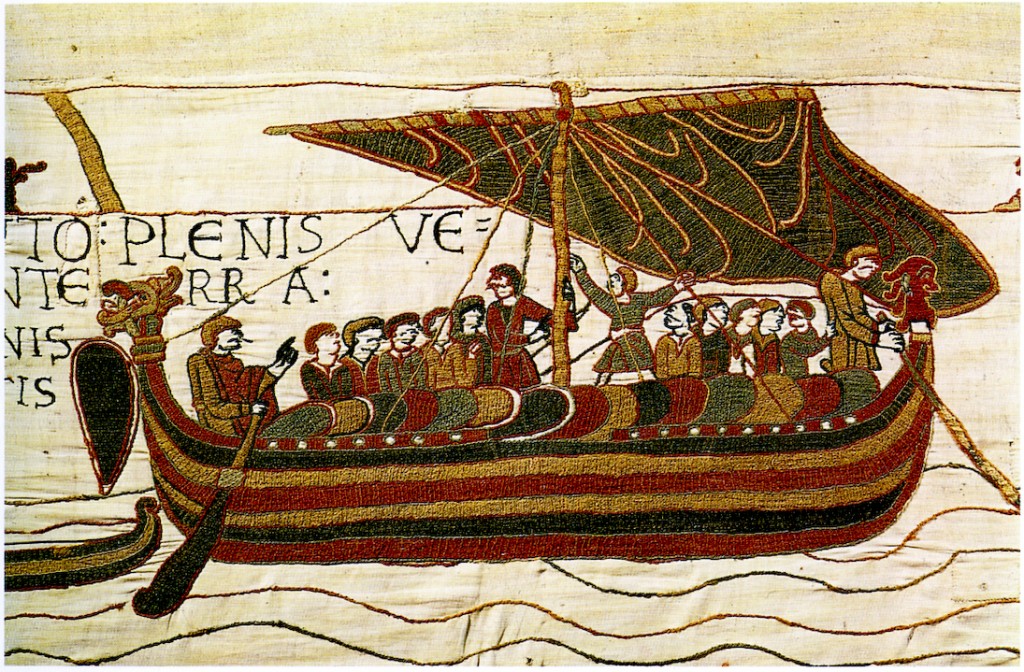 The Bayeux Tapestry, as you probably know, is not a tapestry. It’s an embroidery that tells the story of the Battle of Hastings and of the events leading up to it. The Tapestry is 224 feet long and roughly 18 inches high. It consists of 9 strips of bleached linen that are sewn together and embroidered with colored wools. It is damaged in places, and a final panel is missing, yet the fact that this textile from the late 11th century exists at all is something of a miracle.
The Bayeux Tapestry, as you probably know, is not a tapestry. It’s an embroidery that tells the story of the Battle of Hastings and of the events leading up to it. The Tapestry is 224 feet long and roughly 18 inches high. It consists of 9 strips of bleached linen that are sewn together and embroidered with colored wools. It is damaged in places, and a final panel is missing, yet the fact that this textile from the late 11th century exists at all is something of a miracle.
The first 400 years of the Tapestry’s provenance are a bit of a mystery. Most scholars now believe that it was embroidered in England and that sometime before 1087 it was carried to Bayeux, Normandy among the possessions of its patron Bishop Odo (William the Conqueror’s half-brother). It’s very likely that it was hung in the Bayeux cathedral nave on special occasions, and kept in storage when not in use. If so, it survived Bayeux’s destruction when Henry I torched it in 1106, escaped a devastating cathedral fire in 1159, and survived Bayeux’s destruction by Edward III in 1335. Already it seems to have had a charmed existence, although how it lost that final panel is anybody’s guess.
The tapestry is mentioned for the first time in a 1476 inventory of the cathedral’s treasures which describes “a very long and very narrow strip of linen embroidered with figures and inscriptions representing the Conquest of England”. It was kept with other textiles in the cathedral vestry which, in 1562, was ransacked when French Calvinists attacked the cathedral. They murdered priests, smashed windows, and stole or destroyed centuries-old treasures including precious textiles and items of gold and silver. Somehow, they overlooked the tapestry. Was it ignored because there were no gold or silver threads in it? Or had it been moved to some safe, hidden place? Another mystery. Another close escape.
During the French Revolution, when all church property was nationalized, a Monuments Commission was formed, and ecclesiastical treasures that were not taken to national or local depots were lost or destroyed. The Tapestry once again was spared, coming under the jurisdiction of Bayeux’s Municipal Council. However, in 1792, the Council in its wisdom approved a request by a local military battalion to use the Tapestry to cover their equipment wagons as they made a 350 mile trek south to Meux. Luckily a local administrator convinced the soldiers to use sacking to protect their cargo instead of one of France’s greatest treasures, and he spirited the Tapestry to his office for safekeeping.
Two years later, when a plan in Bayeux surfaced to cut up the Tapestry and decorate a carnival float with it, the new Commission for the Arts said no.
By this time the Tapestry was recognized as a valuable historical artifact, and throughout the 19th century efforts were made to study it, draw it, repair it, conserve it and properly display it. But dangerous times lay ahead. When France was invaded by German troops during the Franco-Prussian War the Tapestry was packed into a protective zinc cylinder and safely hidden away. By 1939 it had its own bomb shelter, but that did not protect it from Himmler’s Ahnenerbe (Ancestral Heritage) team when the Germans occupied France. The Tapestry was displayed privately one evening for elite Wehrmacht and SS officers before it was turned over to a research team that spent a month examining and photographing it. Eventually it was transported 120 miles south to the basement of the Chateau de Sourches near LeMans where it remained for most of the war.
And now we enter the realm of films like Monuments Men and The Imitation Game. Really!
In the spring of 1944, with northern France under heavy Allied bombardment, Himmler began making plans to bring the Tapestry to Germany. The first step would be to move it to Paris, but even before he could order the transfer, the Allied invasion of Normandy had begun.
On June 8 Bayeux was liberated, and within a week Captain LaFarge of the Allies’ Monuments, Fine Arts and Archives division had set up his headquarters there. But the war wasn’t over yet. In early July, per Himmler’s orders, Gestapo officers removed the Tapestry from Sourches and escorted it to the Louvre.
By mid-August, 1944, the Allies were approaching Paris. On August 18 the team at Bletchley Park in England intercepted a radio message from Himmler to the head of the Gestapo in France ordering him to remove the Tapestry to ‘a place of safety’ – presumably closer to the German heartland. On August 22 a team of SS men tried to do just that, but the Louvre was already occupied by Allied troops and the SS men couldn’t get to it. On August 25, Paris was liberated.
The mayor of Bayeux immediately sent a request to Captain LaFarge asking that the Tapestry be returned to Bayeux from Sourches. He didn’t know that it had already been moved to Paris, and one has to wonder if there wasn’t a panic until Captain LaFarge learned that the Tapestry was in the Louvre. Despite the wishes of the mayor of Bayeux, it remained in the Louvre for a time, on exhibit for five weeks. The Tapestry was finally returned to Bayeux in March, 1945. It’s there now. You can see it, behind glass, in its own special gallery, safe and well protected.
Textiles do not age well. Rarely do they withstand the ravages of time, light, air, mold, and insects. That this work of art has survived for a thousand years, giving us a glimpse into such a significant historical event as well as into the minds of those who lived through it, is nothing short of astonishing.
Source: Lewis, Michael J. The Real World of the Bayeux Tapestry. The History Press, Stroud, Gloucestershire, UK, 2008.
Photo Credits: Wikimedia Commons
